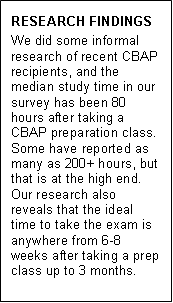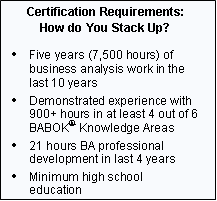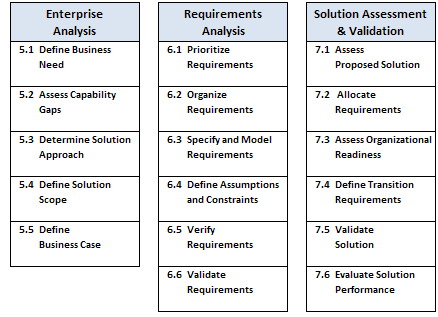What is the CBAP and Why Become CBAP Certified?
The CBAP® (Certified Business Analysis Professional) certification was begun in late 2006 to screen, test, and certify qualified and knowledgeable BAs. We now number over 600 CBAPs around the world, with more being added every week. For people dedicated to the field of business analysis, the CBAP is becoming the "gold standard"of our profession, much like the PMP® is for project management.
The CBAP was created by the IIBA® (International Institute of Business Analysis). For those of you who don't know of it, the IIBA is a non-profit organization to promote the growth and professionalism of business analysis. A large part of IIBA's mission is to document and maintain standards for business analysis, and to recognize and certify practitioners. Visit www.TheIIBA.org for more information, including qualifications you'll need to apply for the exam.
We have a long way to go, admittedly, before the CBAP approaches the stature and recognition of the PMP. But, what will help is encouragement by more employers, such as EDS, The Royal Bank of Canada, Hartford Financial Services Group, and the Chubb Group, to name a few, who are recognizing and encouraging the CBAP certification for their staff.
I'm going out on a limb by saying there are probably thousands of eligible people thinking about or wanting to become certified, but who haven't started yet. There is wide perception from people I've spoken with that both the CBAP application and the exam are difficult. Both thoughts are true. Yet, people do make it through the process! This article briefly summarizes the CBAP program, and how Business Analysts can create a foolproof plan to obtain their certification. The majority of the article covers the 5 crucial steps for your plan and several tips to help you execute it to become certified.
Preparation Plan
 Step 1: Obtain and Skim the BABOK
Step 1: Obtain and Skim the BABOK
One of the many creations of the IIBA has been its A Guide to the Business Analysis Body of Knowledge®, Version 2.0 (called the BABOK® for short). The BABOK is a guide to the generally accepted knowledge and practices in the BA profession. The other significant creation of the IIBA has been the CBAP certification. I am proud to be among the world's first CBAPs. The CBAP exam is based heavily on the BABOK, so the guide is essential to have and to read. You can download it for free from the IIBA if you are a member, and if not, you can purchase a PDF copy from IIBA, or a paper copy through Amazon.com. Version 2.0 is a solid framework, and worth every penny you might spend. Not only will it help you prepare for the CBAP exam, but it can be a valuable reference of the commonly accepted practices for business analysis.
The original and updated CBAP certification exams came from BA task analysis studies. From those, two committees of experts have developed questions for the exam to test the business analysis knowledge of BAs. The questions are based on the BABOK, so knowledge of the information in this guide is essential for passing the exam. We encourage CBAP candidates to read the entire guide, which is 221 pages as of this writing. Step 1, though, should be to skim the guide and familiarize yourself with the BABOK tasks, which will help you complete your application.
Step 2: Apply for the Exam
Before scheduling the CBAP exam, you must apply for it and be accepted by IIBA to sit for the exam. The application requirements are rigorous, and designed for medium- to senior-level business analysts. The sidebar lists the requirements for the exam, which you must meet before you apply.
-
 Visit the IIBA Application page on TheIIBA.Org as your "home"for applying for the CBAP. It has links to the online application and other useful information. Download the Certification Handbook to read an overview of the process. The Application page has a link to the handbook.
Visit the IIBA Application page on TheIIBA.Org as your "home"for applying for the CBAP. It has links to the online application and other useful information. Download the Certification Handbook to read an overview of the process. The Application page has a link to the handbook.
-
Start your online application. We suggest you complete the CBAP Candidate Reference section first.
-
You need to add two references who can attest to your BA knowledge and skills. They could be managers, peers, clients, or other CBAPs.
-
Your references will receive an email form to be completed and returned electronically to the IIBA. Your application can't be completed until your references return their forms, so we advise starting with this step.
-
Complete the Personal Information and Education sections. These are both simple and self-explanatory. You need a high school or higher education, and be prepared to produce a transcript to prove it. You may be audited as I (Rich) was and you will need the transcript.
-
The Work Experience section is extensive. Click "Add New Work Experience" to start it. Before you start, create an electronic record of your projects so you can copy and paste into the online application. Your session may time out if you are interrupted, and you may lose what you entered (there is no intermediate save function). Contact us if you need a template to use.
-
Your application requires a $125 USD fee for applying and it is non-refundable. There is also an exam fee of $325 USD (for members and $450 USD for non-members of IIBA). The IIBA will collect the application fee online when you apply. You will need to send them a check later for the exam once your application has been accepted.
-
You will need to agree to the IIBA Code of Conduct during the application process.
-
Submit your application, pay your fee, and then wait for approval. The IIBA has shortened the wait from 30 down to 21 days with the new online application. Some students tell us their applications have been questioned, so you may be asked to provide more information.
Step 3: Read the Entire BABOK
One your application is submitted, you should begin your preparation in earnest. We recommend that CBAP candidates read the entire BABOK before doing any other preparation. You won't want to try this in one sitting, but plan to read it over time and take notes as you do. Start by listing out the Knowledge Areas and their tasks. There are seven Knowledge Areas, and 32 tasks among them as the following chart shows. Note that the Underlying Competencies Knowledge Area has no tasks and is not listed.


Most people encounter a terminology "eye opener"when reading through the BABOK. What I mean by this is that some or even many of the terms in the BABOK don't agree with your actual practice of business analysis. The tasks and techniques that are brand new to you are one thing, and you will have some learning to do. I consider this to be positive for BA practitioners, since the exam leads us to discover and learn new things.
The trouble you will more likely have is dealing with different terms for the same thing. For instance, I've worked with software packages since 1980 and am quite familiar with them. When I first read about COTS in the BABOK, my reaction was "what are they talking about?"After discovering COTS was an acronym for "Commercial-Off-The-Shelf"software packages, I felt OK again. You will undoubtedly have your own moments of "terminology tension"as you adjust to the IIBA terms. Remember to use and study the BABOK terms, even if they are "wrong"(I mean that tongue in cheek).
Step 4: Absorb the BABOK
Some people may be able to read the BABOK and then pass the exam. Most of us, though, need something more, and a foolproof plan should include additional study to help absorb the key concepts of the BABOK. The three main methods are:
-
Study Groups
-
Classes
-
Individual Study
Study groups are effective ways for many people to study. Being part of a group that meets regularly can be motivating for participants to keep up with studying. Participants report that they learn from each other, they learn by teaching each other, and they help by letting people "think out load." These are all helpful learning aids. You can also benefit in a study group from using flashcards of key terms and concepts and working with a partner to coach and encourage each other.
Prep class. Another beneficial study method is to attend a CBAP preparation class. A class is a way to get your study off to a quick start, and to compress your study time. You get the benefit of learning from the instructor and other students, some of whom you might be able to keep in touch with after class, and form your own study group.
Individual study. If group learning is not your preferred way, or you don't have access to study groups or classes, you need to try the individual approach. Even if you take a class or participate in a study group, you will likely need to do some individual studying. You can create your own study outlines and flashcards as you read the BABOK, and practice using them on your own.
Step 5: Take Practice Exam Questions
In addition to the above methods, practice exams are a great way to prepare. As I was preparing for my PMP exam, I used two books that had questions in them to help me practice. I took numerous practice exams and kept track of my progress. For the Knowledge Areas I was not scoring well in, I did additional reading and studying. The exams are the best feedback in your preparation because they let you know how well you are absorbing the BABOK. There are a small number of online exam questions available on the web and you can find them through a simple Google search.
Step 6: Do Final Preparation
Whatever your methods of studying, you will want to spend your final preparation by focusing on areas you have had trouble with. If you kept track of your practice exam results, focus your final preparation time on the Knowledge Areas, tasks, or techniques that were the most challenging. If you can, practice taking exam questions on those subjects. Make sure to re-read the BABOK in the areas you are struggling with. I did that the day before the exam and it helped me on the exam.
Many people find practicing with flashcards beneficial in the final preparation stages. Start with a broad cross-section of terms and concepts, and narrow them down to the ones you have trouble with. You can make your own flashcards, or purchase them online. Some people like the tactile feel of paper or cardboard flashcards, while others prefer "virtual"flashcards on a computer. There are even audio flashcards available to use while you are driving or exercising.
Your final preparation step should be to get plenty of rest the night before the exam. You will be better served by having a relaxed and rested mind before the exam than by staying up late and cramming. I know of one person who booked a room at a hotel the night before her exam to ensure she would be relaxed and refreshed for the exam. Not everyone needs to or is able to go to that extreme, but it demonstrates a great commitment to preparing for the exam.
Step 7: Take and Pass the Exam
On exam day, make sure you eat a nourishing breakfast or lunch to give you energy during the exam. Drink "enough"water, but not too much. You are able to visit the restroom during the exam, but it uses up some of your allotted time for finishing the exam.
You won't be able to bring anything into the exam that could help you answer questions. You will need to place them into a locker or other storage when you check in for the exam. You should be able to obtain note paper and a pencil at the exam site, and I encourage you to use them during the exam. We advise for both the CBAP and PMP exams that you do a "brain dump"at the start of the exam. Write down key terms, mnemonics, formulae, lists, and sequences. This will help to clear your brain, relieve some test anxiety, and serve as a reference for you during the exam.
Be prepared for four types of questions on the exam:
-
Definitions (e.g., "a model that depicts domain information is...")
-
Sequences (e.g., "what is the first thing you do when...")
-
"Lists of Lists" (e.g., "which of these contains correct attributes? ")
-
Synthesis (e.g., "given this situation, what is going on?")
The exam is comprised of 150 multiple-choice questions, some of them very difficult, some fairly easy, and most are challenging. Intensive exams like the CBAP will typically challenge you by giving you difficult questions at the beginning. Don't get intimated by this! Skip any difficult questions until you find one you are confident of, even if that means skipping the first 20. You have 3.5 hours for all the questions, so you will have plenty of time to go back and review any questions you skipped. You can review any of the questions throughout the exam, and add answers to the questions you skipped after you've built some confidence and momentum.
Summary
If you are like most BA professionals, you haven't taken a major exam like this in a long time, if ever. With the cost of the exam, the amount of time needed to study, and the pressure to pass, you want to make sure you succeed. This article laid out a foolproof plan for passing the CBAP exam in seven steps:
Step 1: Obtain and Skim the BABOK
Step 2: Apply for the Exam
Step 3: Read the Entire BABOK
Step 4: Absorb the BABOK
Step 5: Take Practice Exam Questions
Step 6: Do Final Preparation
Step 7: Take and Pass the Exam
If you follow these 7 steps and devote the 80+ hours of study time needed, you will greatly increase your odds of passing. Above all, try to enjoy the experience. Obtaining a professional certification is an enriching experience, and one to be savored. Well, now that you have your plan, it's time to go and get CBAP certified!
Author: Richard Larson, CBAP, PMP - President, Watermark Learning, Inc.
Watermark Learning helps improve project success with outstanding project management and business analysis training and mentoring. We foster results through our unique blend of industry best practices, a practical approach, and an engaging delivery. We convey retainable real-world skills, to motivate and enhance performance, adding up to enduring results. With our academic partner, Auburn University, Watermark Learning provides Masters Certificate Programs to help organizations be more productive, and assist individuals in their professional growth. Watermark Learning is an IIBA Endorsed Education Provider and a PMI Global Registered Education Provider. Our CBAP Certification Preparation class and CBAP Certification Study Guide have helped numerous people already pass the CBAP exam. For more information, contact us at 800-646-9362, or visit us at www.WatermarkLearning.com.
IIBA®, the IIBA® logo, A Guide to the Business Analysis Body of Knowledge®, BABOK®, CBAP®, and the CBAP® logo are registered trademarks owned by the International Institute of Business Analysis. PMP® is a registered trademark of the Project Management Institute.